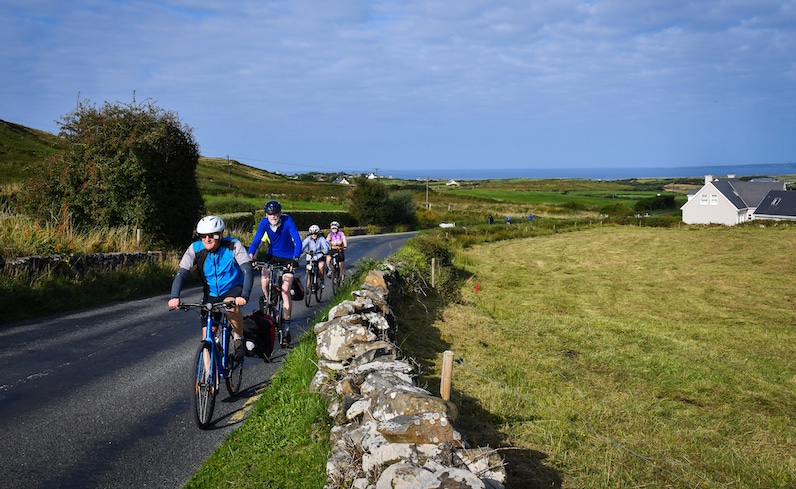
Despite two nights of conviviality in the pubs of Doolin, cyclists nearing the end of their West Ireland tour find the energy to bike up to the Cliffs of Moher. Photo by John Poimiroo
By John Poimiroo
The Irish are survivors. They’ve suffered Viking slavers, the Norman conquest, oppressive British landowners and famine. Yet, despite these adversities, the Irish are an ebullient people with stirring music, a welcoming attitude and a kind spirit.
Look closely at the grassy hillsides surrounding Leenaun and you’ll see parallel horizontal lines that are remnants from the Great Famine. Desperate for a way to grow potatoes, the Irish created terraces on the mountainsides in the mistaken belief that better soil would improve crop yields. What they didn’t know in the late 1840s was that disease was destroying potato plants and no amount of terracing could change that.
The Great Famine is remembered with a monument commemorating the Doolough Tragedy of 1849 in which starving families, dependent upon relief, were told to meet British agents to verify their need for continued assistance. Instead of going to the agreed meeting point, however, the British went 12 miles south and instructed poor supplicants to meet them there. Hundreds of famished families wearing little more than rags trudged across the freezing Doolough Pass at night. When they arrived they were told there was nothing to eat by officials who dismissed them, after first enjoying their breakfast.
Frail bodies littered the pass the Irish labored to cross or were blown into Fin Lough by strong winds. Many corpses were found with grass in their mouths from one last, futile attempt at nourishment.
This ride is well worth the physical effort. The route travels beside one of three glacial fjords in Ireland, a ribbon of twisting blue that passes between lovely hills that once were stained with tears. In Irish, Doolough means “black lake.” Upon the monument, an inscription from Mahatma Ghandi reads, “How can men feel themselves honored by the humiliation of their fellow beings?”
From Leenaun on, the ride is uplifting. You follow the Connemara Loop past Kylemore Abbey, a gingerbready, much-photographed Victorian castle that now is home to a community of Benedictine nuns. Then pedal through Connemara National Park toward the breathtaking views of the Twelve Bens before descending into the seaside town of Clifden.
Grant, a cyclist from Arkansas, said he was prepared for Ireland’s greenery, but was surprised by the size of what the Irish call their “hills,” which look more like mountains. Gaelic has many names for hill: beinn (ben), cárn, sgùrr, meall, druim, aonach and numerous others, yet the Irish call even the tallest of their mountains, hills.
In the U.S., the difference between hills and mountains was officially 1,000 feet, until the distinction was abandoned in the 1970s. Today, apparently, even an American molehill can be called a mountain, though in Ireland, everything’s a hill.
“Picturesque” is an overused word, but not in Clifden’s case. It has a charming fishing harbor vibe with town buildings colored pink, orange, blue, white, red and mint green. Why the varied palette? “To brighten dreary days” a Clifden local explained.
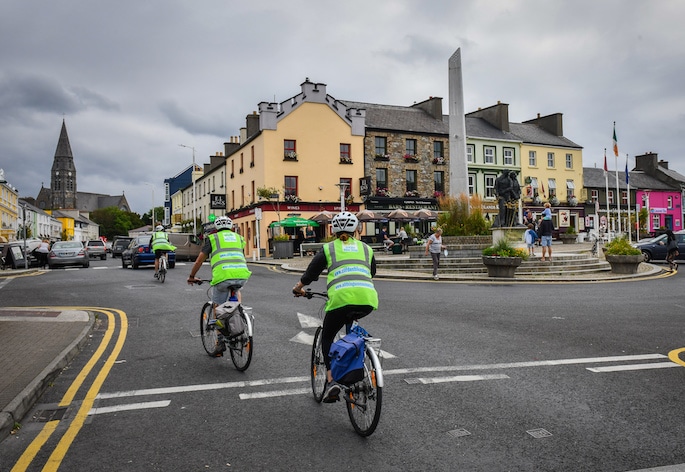
Clifdon is a great town for bicycles since traffic flows at a measured pace. Photo by John Poimiroo
The town square honors aviation pioneers John Alcock and Arthur Brown who, in 1919, landed nearby, successfully completing the first non-stop transatlantic flight. Eight years later, Charles Lindbergh made the first solo flight across the Atlantic from New York to Paris in 34 hours.
Stores, restaurants, and pubs aren’t “touristy.” Shops sell Aran sweaters, but mostly the stores attract locals with goods a visitor also can appreciate. Sean Price, the butcher at Moran’s Meats is happy to explain how he makes white and black sausage pudding. E. J. Kings is one of Ireland’s Joyce Pubs. The clientele is decidedly local, cheering televised Irish football as their pints warm and their fish and chips cool
You can dine wherever you want on a cycling tour, but more often those sharing the journey also dine together. This means, fine dining usually gives way to pub fare. Common choices range from seasoned burgers, Irish stew, pan-fried salmon and Killary mussels to fish and chips with fresh cod and tartar sauce (never vinegar – that’s English). Potatoes fried, boiled, or mashed come in abundance. No meal is complete without a pint of Guinness, but French wine or cider also are available.
From Clifden, the tour cycles south across the Old Bog Road, a one-and-a-half-lane strip that passes through lush heather and rock outcroppings with distant views of Twelve Bens and the Maumturks Mountains.
For Bostonians Beth and Lindsay, the trip was a way for Beth to celebrate her 40th birthday. She came, “Just to have fun and drink some Guinness,” adding “Anyone who has the chance to do this, should do so. It’s stunning scenery.”
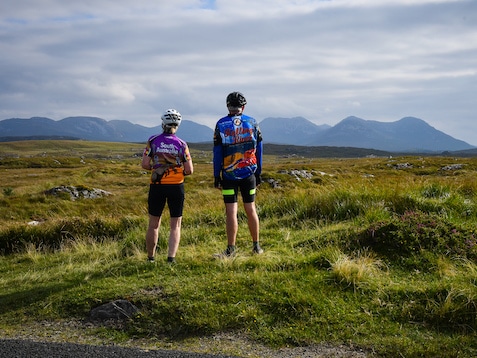
Cyclists on the Bog Road often stop to survey the enormous bog that blankets the land. Though it holds enormous amounts of water, it is not swampy. Photo by John Poimiroo
Along the Bog Road, heather embellished with pink, lavender and yellow flowers wraps around ancient rock formations. Legend says it’s good luck to find white flowers amidst the heather. Cyclists have time to search for white flowers while riding along the road and they’ll need luck should they encounter any of the ghosts of Neolithic farmers said to haunt the bog.
Bogs act like rainforests. They absorb water and release it slowly throughout the year, feeding streams of spawning salmon and trout. For centuries bogs have been a primary source of heating fuel for Irish homes. Even today, stacks of “turf” along the bog road wait to be used to heat Irish homes. Their pungent smell (called “peat reek”) permeates the roadside air, reminding one of a jigger of Jameson. Ireland’s best-selling whiskey dries its malt over a peat-heated fire, conveying a smoky flavor to the barley grain and giving the whiskey its distinctive taste.
On Day five, cyclists ferry their bikes over to Inis Mór, the largest and westernmost of Ireland’s Aran Islands, but with only 840 residents. This is a day spent exploring with little riding. More forgotten cottages and rock walls lattice the island. Local tour driver, Noel Moher, a “blow in” who married a local girl, says they were owned by bachelors whose American cousins inherited them but have no plan to renovate the 200-year-old structures.
Connemara pony carts and tour buses climb to the island’s main attraction, the pre-historic Dún Aonghasa, a massive fortress that backs up to sheer 330-foot cliffs above the Atlantic Ocean. Irish archeologist George Petrie called it “the most magnificent barbaric monument in Europe.” It’s so old (1,100 B.C.) that there’s no record of who it defended the Irish from, though a cheveaux-de-frise (defensive barrier) of jagged, upright stones leaves no doubt it once was a fortress.
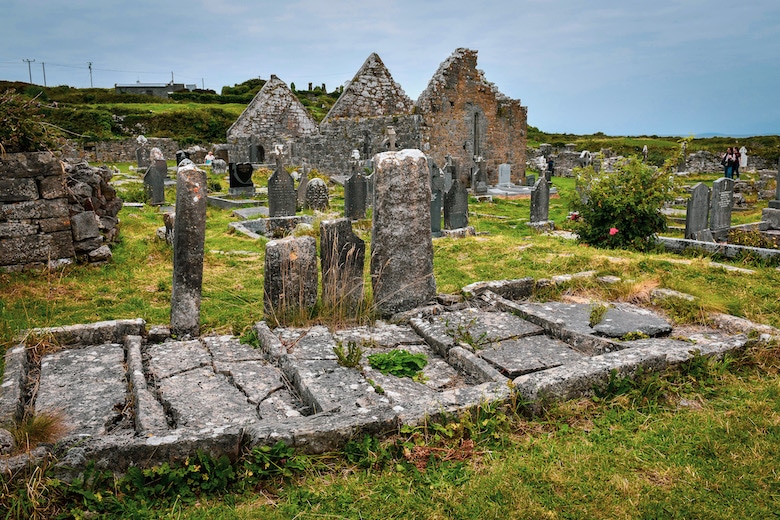
The Abbey of the Seven Churches on Inis Mór contains the 9th-century graves of seven Roman scholars who traveled to remote Aran Island because barbarians had destroyed most of the books throughout the fallen Roman Empire. Photo by John Poimiroo
Thomas Cahill writes in How the Irish Saved Civilization, that were it not for Irish monks during the dark ages, all previous learning would have been lost. Just as mainland Europe was experiencing economic, intellectual and cultural decline, which stemmed from the fall of the Roman Empire, Ireland had just ended a long period of economic and intellectual stagnation. The abbey on Inis Mór became one of Europe’s remaining learning centers, rescuing books that were being discarded across the continent. Scholars came from afar to study. At the Abbey of the Seven Churches on Inis Mór the 9th-century graves of seven Romans, who had traveled to this remote island from Imperial Rome to study, testify to the fame of Aran’s schools.
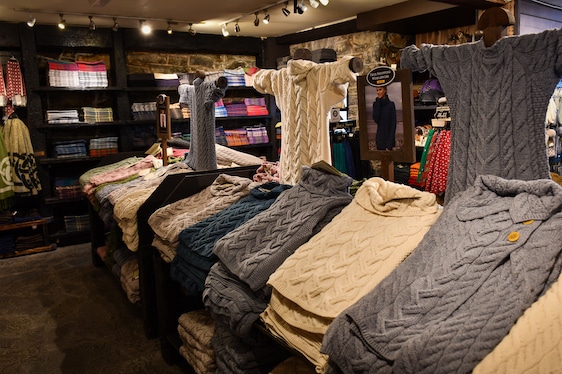
Most of the world calls them sweaters, but in Ireland they are Aran Jumpers. In a country of near-perpetual rain, the cable-knit garment is beloved because its wool sheds water. Photo by John Poimiroo
Today, the Aran Islands’ greatest claim to fame is its sweater. The Aran Jumper is an off-white, cable-knit cardigan made famous by local fishermen who found that the lanolin from Connemara wool sheds water and keeps them warm, even when the sweater is soaked. Shops sell many styles of Aran sweaters. It’s hard to resist purchasing one when visiting the Aran Islands.
On the ferry ride back to mainland Ireland, you see the objective of the following day’s ride, the imposing Cliffs of Moher.
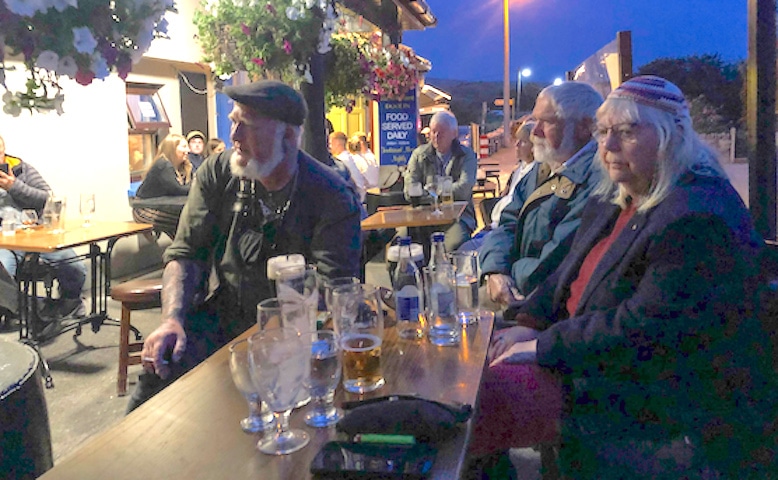
Doolin seniors enjoy a balmy summer evening on the terrace of McGadden’s Pub. Photo by John Poimiroo
A B&B in Doolin is your home for the next two nights. A center of traditional Irish music, Doolin, is the quintessential Irish village. Its main road bends to the contours of the village creek, which is crossed at several points by stone bridges. Shops, restaurants, inns and its four pubs are brightly painted pink, yellow and lime green to ward off winter blues.
On a typical evening, townsfolk and visitors gather at McGadden’s Pub to hear local singers and musicians perform lively Irish Trad. Sometimes, the house band is augmented by patrons. One night a lass broke away from her girlfriends to sing Ed Sheeran’s The Parting Glass. On another, a white-haired local farmer with a chin beard and braided goatee sang an emotional Sean-nós.
“… And we’ll all go together
To pluck wild mountain thyme
All around the blooming heather
Will ye go lassie, go?”
He was followed by a 22-year old tenor who expressed sorrow over the loss of a fair lass in a lament called a Caoineadh.
“… So softly fills my room,
with her haunting sweet perfume,
here then gone forever,
my bonnie Belfast rose,”
Then, in an electric moment the multi-generational audience of greying seniors, young parents with children and lassies holding a celebratory bridal shower joined a few cyclists visiting Doolin for the first time to sing the ending refrain,
“… Farewell my restless visions,
gone like glad old clothes,
some you keep forever,
but not my Belfast rose.”
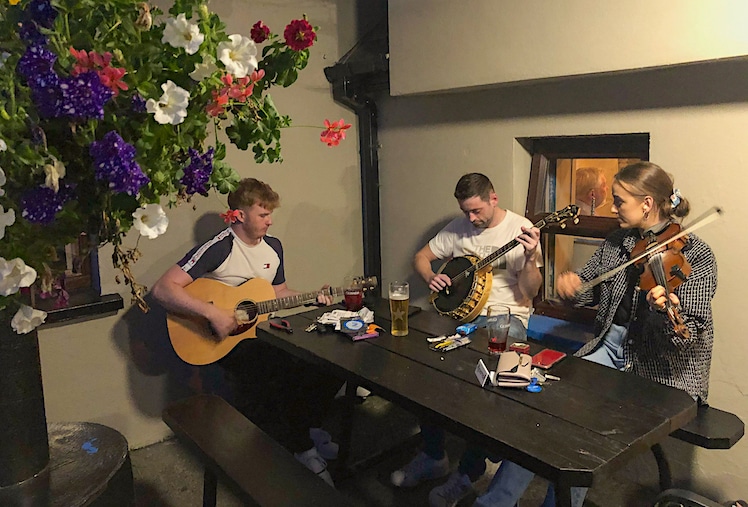
Young musicians play Irish “trad” at McGadden’s Pub in Doolin. Photo by John Poimiroo
Cycling up out of Doolin the following morning towards the Cliffs of Moher, there is a sense that something great lies ahead. Our destination: a sheer, 700-ft. wall of stone extending nine miles along the western coast of County Clare.
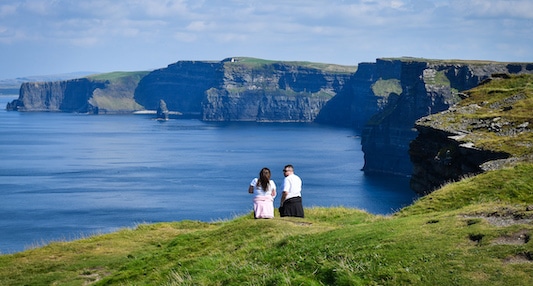
The dramatic Cliffs of Moher are the most visited natural attraction in Ireland Photo by John Poimiroo
A million visitors walk the cliffs each year, making it Ireland’s favorite tourist attraction. A visually stunning visitor center built into a hillside contains a world-class museum with interactive multi-media exhibits that animate the history, geology and flora of the area. Some travelers venture close to the Burren’s precipitous edge to look hundreds of feet down at the sea. The experience not for the faint-hearted.
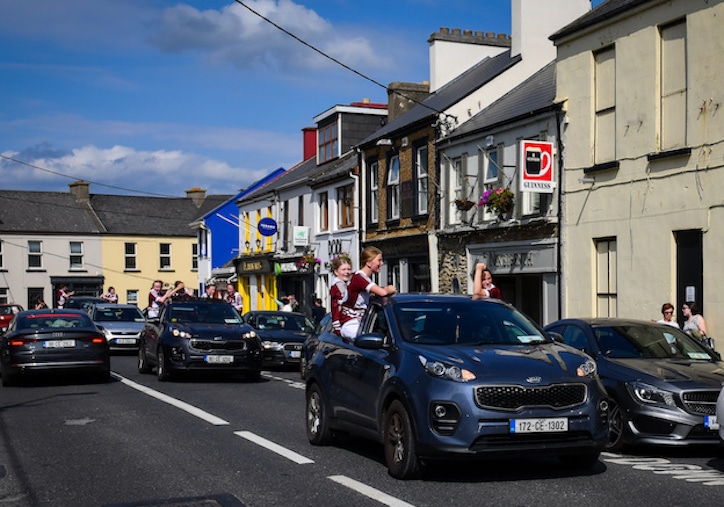
The good people of Lahinch were sanguine recently when a girl’s football team from a neighboring town celebrated their victory a bit ostentatiously. Few would speculate what the reaction might have been if a rival men’s team might have won. Photo by John Poimiroo
Riding south from the cliffs, the tour reaches its southern-most point in the town of Lahinch which is celebrated for its golf course. The Lahinch clubhouse bar is considered by golfers to be one of the best in Ireland, as is Lahinch’s Cornerstone Pub.
While in Lahinch, the town erupted with blaring car horns as the winning girls’ football team from rival Liscannor, across the bay, celebrated their victory against Lahinch by driving through town with fists raised. The people of Lahinch exhibited restrained sportsmanship by applauding the Liscannor girls. Scenes like this, prosaic yet profound, say a lot about a place and can only be experienced when you have the immediacy of the moment allowed on a bike.
Our return from Lahinch took us down a brake-burning descent and past Doonagore castle before arriving in Doolin for another night of Irish music and dining. Standing outside McGadden’s Bar, locals quickly knew the cyclists were tourists. “The Americans are back,” one said under his breath, so as not to offend. Another approached a cyclist and posed an oft-asked question, “Do you have blood?” Meaning, “Are you of Irish descent?”
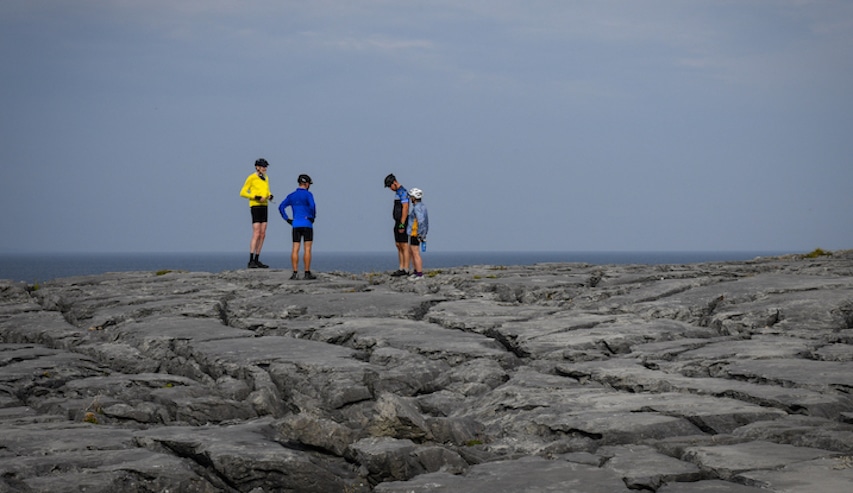
The Burren of County Clare is an area of rocky limestone left desolate eons ago by an ice-age glacier. Over the centuries, Ireland’s incessant rain has furrowed the rock. Photo by John Poimiroo
The Irish share a kinship with America and missed seeing Americans during the pandemic. More than 31.5 million Americans claim Irish descent. That’s six times more Irish-Americans than the entire population of Ireland. Soon, everyone at McGadden’s – the Irish and visitors alike – were tapping their toes, sipping their pints and smiling as the musicians played on.
The following morning, a 30 km pedal north to Ballyvaughn brought the tour into the heart of The Burren, a barren, glacier-scoured, limestone moonscape that touches the Atlantic. Deep cracks cross the grey stone shelves were etched away over centuries as calcite veins were washed away by rainwater.
In Ballyvaughn there was still time to explore the barren Burren. The cycling tour would end the next day so several in the group chose to ride up to the 10th century Caherconnell Cashel ringfort, as it would be closed the following morning when the group rode past.
Poulabrone Dolmen, near the ringfort, is a 5,000-year-old burial ground that served as a location for Bronze Age ceremonies and rituals. Resembling a mini-Stonehenge, the Dolmen’s archeological digs have yielded artifacts found among the ancients buried there.
Beyond the Dolmen is the privately managed Caherconnell Cashel, a medieval-era stone ringfort that protected local inhabitants from Viking raids as early as the 10th century on a site known to be inhabited as early as the 7th century B.C.
Colin Davoren stood inside its visitor center answering questions from people just arrived. He is a descendant of Davorens who have farmed this land for centuries. Their name literally means, “of the Burren.”
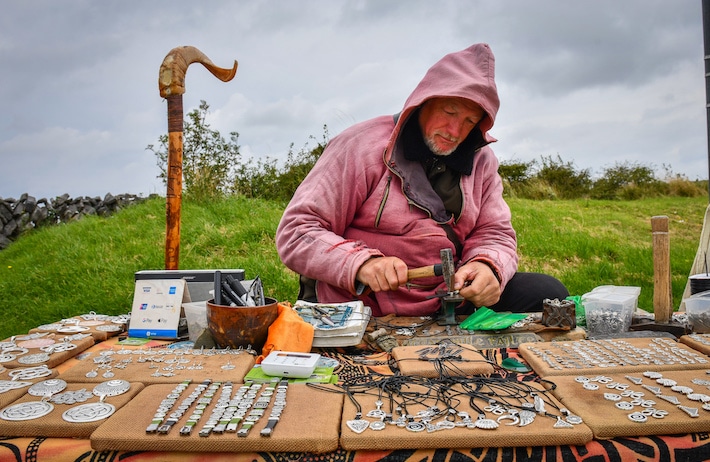
Tomas O’Cadhain sells artifacts near the Dolmen. Photo by John Poimiroo
“Caherconnell has kept our family here,” he admits. “There’s a cultural magnetism that keeps us coming back. I remember as a small boy the fort was my playground.”
Archaeologists believe an agricultural settlement at Caherconnell was established in the late 10th century and that occupation continued to the 17th century. The Caherconnel ring, a delicate medieval silver ring inscribed with a Celtic symbol was found during excavation and five wives within the Davoren family each received a replica. Additional replicas are sold in the visitor center’s store and contribute to the maintenance of the site.
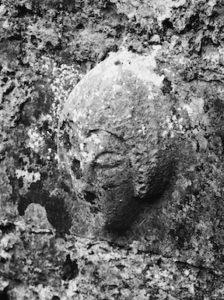
For more than six centuries this Irish Knight has watched over Carran Church. The church is in ruins but the Knight remains vigilant. Photo by John Poimiroo
From the 13th to 16th centuries, Carran church, a short distance beyond the ringfort, was the primary place of worship in The Burren. The church was self-fortified to defend against local attacks. A three-dimensional face of an Irish knight wearing a helmet protrudes from an interior wall. Inside the church is the ancient Celtic cross of the Davoren family plot, indicating the family’s prominence through the ages.
At Carran, another family owns Burren Perfumery, which makes perfumes and cosmetics inspired by the Irish landscape. In the Blending Room, visitors can watch Rose and Cate make organic balms and creams. There’s a garden to tour and a small cafe where local women serve homemade soup and freshly baked bread in addition to local cheeses and cakes. But mostly, there’s a sense that you’re at an authentic place where the people of The Burren, not corporations or marketing experts, decided which perfume or soap to sell.
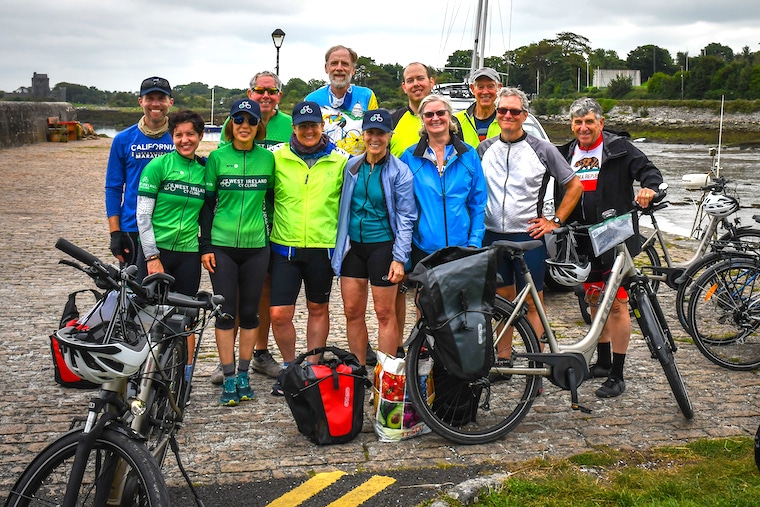
Eight days of pedaling from Galway to Kinvara end for the 12 cyclists on the West Ireland Cycling tour.
The final pedal from Carran to Kinvara is a long, downhill stretch along an empty, one-lane road banked by hedges of Irish hazel. It provided time to reflect on the people of West Ireland whose history and culture can best be experienced from a bicycle rolling down a country road. ![]()
John Poimiroo is a travel writer/photographer living in California’s Sierra Nevada near Sacramento. He is a member of the local American River Bike Patrol. This is his first story about bicycle touring for the East-West News Service.

